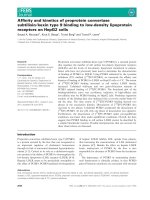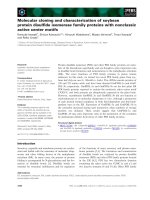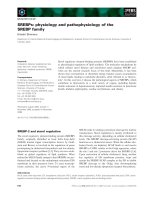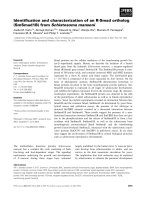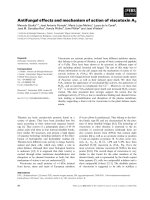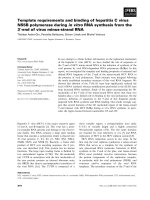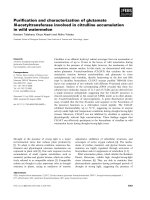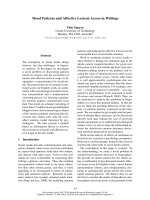Báo cáo khoa học: "Automatic Detection and Correction of Errors in Dependency Treebanks" potx
Bạn đang xem bản rút gọn của tài liệu. Xem và tải ngay bản đầy đủ của tài liệu tại đây (178.79 KB, 5 trang )
Proceedings of the 49th Annual Meeting of the Association for Computational Linguistics:shortpapers, pages 346–350,
Portland, Oregon, June 19-24, 2011.
c
2011 Association for Computational Linguistics
Automatic Detection and Correction of Errors in Dependency Tree-
banks
Alexander Volokh
DFKI
Stuhlsatzenhausweg 3
66123 Saarbrücken, Germany
Günter Neumann
DFKI
Stuhlsatzenhausweg 3
66123 Saarbrücken, Germany
Abstract
Annotated corpora are essential for almost all
NLP applications. Whereas they are expected
to be of a very high quality because of their
importance for the followup developments,
they still contain a considerable number of er-
rors. With this work we want to draw attention
to this fact. Additionally, we try to estimate
the amount of errors and propose a method for
their automatic correction. Whereas our ap-
proach is able to find only a portion of the er-
rors that we suppose are contained in almost
any annotated corpus due to the nature of the
process of its creation, it has a very high pre-
cision, and thus is in any case beneficial for
the quality of the corpus it is applied to. At
last, we compare it to a different method for
error detection in treebanks and find out that
the errors that we are able to detect are mostly
different and that our approaches are comple-
mentary.
1 Introduction
Treebanks and other annotated corpora have be-
come essential for almost all NLP applications. Pa-
pers about corpora like the Penn Treebank [1] have
thousands of citations, since most of the algorithms
profit from annotated data during the development
and testing and thus are widely used in the field.
Treebanks are therefore expected to be of a very
high quality in order to guarantee reliability for
their theoretical and practical uses. The construc-
tion of an annotated corpus involves a lot of work
performed by large groups. However, despite the
fact that a lot of human post-editing and automatic
quality assurance is done, errors can not be
avoided completely [5].
In this paper we propose an approach for find-
ing and correcting errors in dependency treebanks.
We apply our method to the English dependency
corpus – conversion of the Penn Treebank to the
dependency format done by Richard Johansson and
Mihai Surdeanu [2] for the CoNLL shared tasks
[3]. This is probably the most used dependency
corpus, since English is the most popular language
among the researchers. Still we are able to find a
considerable amount of errors in it. Additionally,
we compare our method with an interesting ap-
proach developed by a different group of research-
ers (see section 2). They are able to find a similar
number of errors in different corpora, however, as
our investigation shows, the overlap between our
results is quite small and the approaches are rather
complementary.
2 Related Work
Surprisingly, we were not able to find a lot of work
on the topic of error detection in treebanks. Some
organisers of shared tasks usually try to guarantee
a certain quality of the used data, but the quality
control is usually performed manually. E.g. in the
already mentioned CoNLL task the organisers ana-
lysed a large amount of dependency treebanks for
different languages [4], described problems they
have encountered and forwarded them to the de-
velopers of the corresponding corpora. The only
work, that we were able to find, which involved
automatic quality control, was done by the already
mentioned group around Detmar Meurers. This
work includes numerous publications concerning
finding errors in phrase structures [5] as well as in
dependency treebanks [6]. The approach is based
on the concept of “variation detection”, first intro-
duced in [7]. Additionally, [5] presents a good
346
method for evaluating the automatic error detec-
tion. We will perform a similar evaluation for the
precision of our approach.
3 Variation Detection
We will compare our outcomes with the results
that can be found with the approach of “variation
detection” proposed by Meurers et al. For space
reasons, we will not be able to elaborately present
this method and advise to read the referred work,
However, we think that we should at least briefly
explain its idea.
The idea behind “variation detection” is to find
strings, which occur multiple times in the corpus,
but which have varying annotations. This can obvi-
ously have only two reasons: either the strings are
ambiguous and can have different structures, de-
pending on the meaning, or the annotation is erro-
neous in at least one of the cases. The idea can be
adapted to dependency structures as well, by ana-
lysing the possible dependency relations between
same words. Again different dependencies can be
either the result of ambiguity or errors.
4 Automatic Detection of Errors
We propose a different approach. We take the Eng-
lish dependency treebank and train models with
two different state of the art parsers: the graph-
based MSTParser [9] and the transition-based
MaltParser [10]. We then parse the data, which we
have used for training, with both parsers. The idea
behind this step is that we basically try to repro-
duce the gold standard, since parsing the data seen
during the training is very easy (a similar idea in
the area of POS tagging is very broadly described
in [8]). Indeed both parsers achieve accuracies
between 98% and 99% UAS (Unlabeled Attach-
ment Score), which is defined as the proportion of
correctly identified dependency relations. The reas-
on why the parsers are not able to achieve 100% is
on the one hand the fact that some of the phenom-
ena are too rare and are not captured by their mod-
els. On the other hand, in many other cases parsers
do make correct predictions, but the gold standard
they are evaluated against is wrong.
We have investigated the latter case, namely
when both parsers predict dependencies different
from the gold standard (we do not consider the cor-
rectness of the dependency label). Since MSTPars-
er and MaltParser are based on completely differ-
ent parsing approaches they also tend to make dif-
ferent mistakes [11]. Additionally, considering the
accuracies of 98-99% the chance that both parsers,
which have different foundations, make an erro-
neous decision simultaneously is very small and
therefore these cases are the most likely candidates
when looking for errors.
5 Automatic Correction of Errors
In this section we propose our algorithm for auto-
matic correction of errors, which consists out of
the following steps:
1. Automatic detection of error candidates,
i.e. cases where two parsers deliver results
different to gold-standard.
2. Substitution of the annotation of the error
candidates by the annotation proposed by
one of the parsers (in our case
MSTParser).
3. Parse of the modified corpus with a third
parser (MDParser).
4. Evaluation of the results.
5. The modifications are only kept for those
cases when the modified annotation is
identical with the one predicted by the
third parser and undone in other cases.
For the English dependency treebank we have
identified 6743 error candidates, which is about
0.7% of all tokens in the corpus.
The third dependency parser, which is used is
MDParser
1
- a fast transition-based parser. We sub-
situte the gold standard by MSTParser and not
MaltParser in order not to give an advantage to a
parser with similar basics (both MDParser and
MDParser are transition-based).
During this experiment we have found out that
the result of MDParser significantly improves: it is
able to correctly recgonize 3535 more dependen-
cies than before the substitution of the gold stand-
ard. 2077 annotations remain wrong independently
of the changes in the gold standard. 1131 of the re-
lations become wrong with the changed gold
standard, whereas they were correct with the old
unchanged version. We then undo the changes to
the gold standard when the wrong cases remained
wrong and when the correct cases became wrong.
We suggest that the 3535 dependencies which be-
came correct after the change in gold standard are
1
347
errors, since a) two state of the art parsers deliver a
result which differs from the gold standard and b) a
third parser confirms that by delivering exactly the
same result as the proposed change. However, the
exact precision of the approach can probably be
computed only by manual investigation of all cor-
rected dependencies.
6 Estimating the Overall Number Of Er-
rors
The previous section tries to evaluate the precision
of the approach for the identified error candidates.
However, it remains unclear how many of the er-
rors are found and how many errors can be still ex-
pected in the corpus. Therefore in this section we
will describe our attempt to evaluate the recall of
the proposed method.
In order to estimate the percentage of errors,
which can be found with our method, we have de-
signed the following experiment. We have taken
sentences of different lengths from the corpus and
provided them with a “gold standard” annotation
which was completely (=100%) erroneous. We
have achieved that by substituting the original an-
notation by the annotation of a different sentence
of the same length from the corpus, which did not
contain dependency edges which would overlap
with the original annotation. E.g consider the fol-
lowing sentence in the (slightly simplified) CoNLL
format:
1 Not RB 6 SBJ
2 all PDT 1 NMOD
3 those DT 1 NMOD
4 who WP 5 SBJ
5 wrote VBD 1 NMOD
6 oppose VBP 0 ROOT
7 the DT 8 NMOD
8 changes NNS 6 OBJ
9 . . 6 P
We would substitute its annotation by an annota-
tion chosen from a different sentence of the same
length:
1 Not RB 3 SBJ
2 all PDT 3 NMOD
3 those DT 0 NMOD
4 who WP 3 SBJ
5 wrote VBD 4 NMOD
6 oppose VBP 5 ROOT
7 the DT 6 NMOD
8 changes NNS 7 OBJ
9 . . 3 P
This way we know that we have introduced a
well-formed dependency tree (since its annotation
belonged to a different tree before) to the corpus
and the exact number of errors (since randomly
correct dependencies are impossible). In case of
our example 9 errors are introduced to the corpus.
In our experiment we have introduced sen-
tences of different lengths with overall 1350
tokens. We have then retrained the models for
MSTParser and MaltParser and have applied our
methodology to the data with these errors. We
have then counted how many of these 1350 errors
could be found. Our result is that 619 tokens
(45.9%) were different from the erroneous gold-
standard. That means that despite the fact that the
training data contained some incorrectly annotated
tokens, the parsers were able to annotate them dif-
ferently. Therefore we suggest that the recall of our
method is close to the value of 0.459. However, of
course we do not know whether the randomly in-
troduced errors in our experiment are similar to
those which occur in real treebanks.
7 Comparison with Variation Detection
The interesting question which naturally arises at
this point is whether the errors we find are the
same as those found by the method of variation de-
tection. Therefore we have performed the follow-
ing experiment: We have counted the numbers of
occurrences for the dependencies
B A
(the
word B is the head of the word A) and
C A
(the word C is the head of the word A), where
B A
is the dependency proposed by the pars-
ers and
C A
is the dependency proposed by
the gold standard. In order for variation detection
to be applicable the frequency counts for both rela-
tions must be available and the counts for the de-
pendency proposed by the parsers should ideally
greatly outweigh the frequency of the gold stand-
ard, which would be a great indication of an error.
For the 3535 dependencies that we classify as er-
rors the variation detection method works only 934
times (39.5%). These are the cases when the gold
standard is obviously wrong and occurs only few
times, most often - once, whereas the parsers pro-
348
pose much more frequent dependencies. In all oth-
er cases the counts suggest that the variation detec-
tion would not work, since both dependencies have
frequent counts or the correct dependency is even
outweighed by the incorrect one.
8 Examples
We will provide some of the example errors, which
we are able to find with our approach. Therefore
we will provide the sentence strings and briefly
compare the gold standard dependency annotation
of a certain dependency within these sentences.
Together, the two stocks wreaked havoc among
takeover stock traders, and caused a 7.3% drop in
the DOW Jones Transportation Average, second in
size only to the stock-market crash of Oct. 19
1987.
In this sentence the gold standard suggests the
dependency relation
market the
, whereas
the parsers correctly recognise the dependency
crash the
. Both dependencies have very
high counts and therefore the variation detection
would not work well in this scenario.
Actually, it was down only a few points at the
time.
In this sentence the gold standard suggests
points at
, whereas the parsers predict
was at
. The gold standard suggestion occurs
only once whereas the temporal dependency
was at
occurs 11 times in the corpus. This is
an example of an error which could be found with
the variation detection as well.
Last October, Mr. Paul paid out $12 million of
CenTrust's cash – plus a $1.2 million commission
– for “Portrait of a Man as Mars”.
In this sentence the gold standard suggests the
dependency relation
$ a
, whereas the parsers
correctly recognise the dependency
commission a
. The interesting fact is that
the relation
$ a
is actually much more fre-
quent than
commission a
, e.g. as in the sen-
tence he cought up an additional $1 billion or so.
(
$ an
) So the variation detection alone
would not suffice in this case.
9 Conclusion
The quality of treebanks is of an extreme import-
ance for the community. Nevertheless, errors can
be found even in the most popular and widely-used
resources. In this paper we have presented an ap-
proach for automatic detection and correction of
errors and compared it to the only other work we
have found in this field. Our results show that both
approaches are rather complementary and find dif-
ferent types of errors.
We have only analysed the errors in the head-
modifier annotation of the dependency relations in
the English dependency treebank. However, the
same methodology can easily be applied to detect
irregularities in any kind of annotations, e.g. labels,
POS tags etc. In fact, in the area of POS tagging a
similar strategy of using the same data for training
and testing in order to detect inconsistencies has
proven to be very efficient [8]. However, the meth-
od lacked means for automatic correction of the
possibly inconsistent annotations. Additionally, the
method off course can as well be applied to differ-
ent corpora in different languages.
Our method has a very high precision, even
though we could not compute the exact value,
since it would require an expert to go through a
large number of cases. It is even more difficult to
estimate the recall of our method, since the overall
number of errors in a corpus is unknown. We have
described an experiment which to our mind is a
good attempt to evaluate the recall of our ap-
proach. On the one hand the recall we have
achieved in this experiment is rather low (0.459),
which means that our method would definitely not
guarantee to find all errors in a corpus. On the oth-
er hand it has a very high precision and thus is in
any case beneficial, since the quality of the tree-
banks increases with the removal of errors. Addi-
tionally, the low recall suggests that treebanks con-
tain an even larger number of errors, which could
not be found. The overall number of errors thus
seems to be over 1% of the total size of a corpus,
which is expected to be of a very high quality. A
fact that one has to be aware of when working with
annotated resources and which we would like to
emphasize with our paper.
10 Acknowledgements
The presented work was partially supported by a
grant from the German Federal Ministry of Eco-
nomics and Technology (BMWi) to the DFKI
Theseus project TechWatch—Ordo (FKZ: 01M-
Q07016).
349
References
[1] Mitchell P. Marcus, Beatrice Santorini and Mary
Ann Marcinkiewicz , 1993. Building a Large Annot-
ated Corpus of English: The Penn Treebank. In Com-
putational Lingustics, vol. 19, pp. 313-330.
[2] Mihai Surdeanu, Richard Johansson, Adam Meyers,
Lluis Marquez and Joakim Nivre. The CoNLL-2008
Shared Task on Joint Parsing of Syntactic and Se-
mantic Dependencies. In Proceedings of the 12th
Conference on Computational Natural Language
Learning (CoNLL-2008), 2008
[3] Sabine Buchholz and Erwin Marsi, 2006. CoNLL-X
shared task on multilingual dependency parsing. In
Proceedings of CONLL-X, pages 149–164, New
York.
[4] Sabine Buchholz and Darren Green, 2006. Quality
control of treebanks: documenting, converting,
patching. In LREC 2006 workshop on Quality assur-
ance and quality measurement for language and
speech resources.
[5] Markus Dickinson and W. Detmar Meurers, 2005.
Prune Diseased Branches to Get Healthy Trees!
How to Find Erroneous Local Trees in a Treebank
and Why It Matters. In Proceedings of the Fourth
Workshop on Treebanks and Linguistic Theories, pp.
41—52
[6] Adriane Boyd, Markus Dickinson and Detmar Meur-
ers, 2008. On Detecting Errors in Dependency Tree-
banks. In Research on Language and Computation,
vol. 6, pp. 113-137.
[7] Markus Dickinson and Detmar Meurers, 2003. De-
tecting inconsistencies in treebanks. In Proceedings
of TLT 2003
[8] van Halteren, H. (2000). The detection of inconsist-
ency in manually tagged text. In A. Abeillé, T.
Brants, and H. Uszkoreit (Eds.), Proceedings of the
Second Workshop on Linguistically Interpreted Cor-
pora (LINC-00), Luxembourg.
[9 R. McDonald, F. Pereira, K. Ribarov, and J. Haji˘c .
2005. Non-projective Dependency Parsing using
Spanning Tree Algorithms. In Proc. of HLT/EMNLP
2005.
[10] Joakim Nivre, Johan Hall, Jens Nilsson, Atanas
Chanev, Gulsen Eryigit, Sandra Kubler, Svetoslav
Marinov and Erwin Marsi. 2007. MaltParser: A
Language-Independent System for Data-Driven De-
pendency Parsing, Natural Language Engineering
Journal, 13, pp. 99-135.
[11] Joakim Nivre and Ryan McDonald, 2008. Integrat-
ing GraphBased and Transition-Based Dependency
Parsers. In Proceedings of the 46th Annual Meeting
of the Association for Computational Linguistics:
Human Language Technologies.
350
